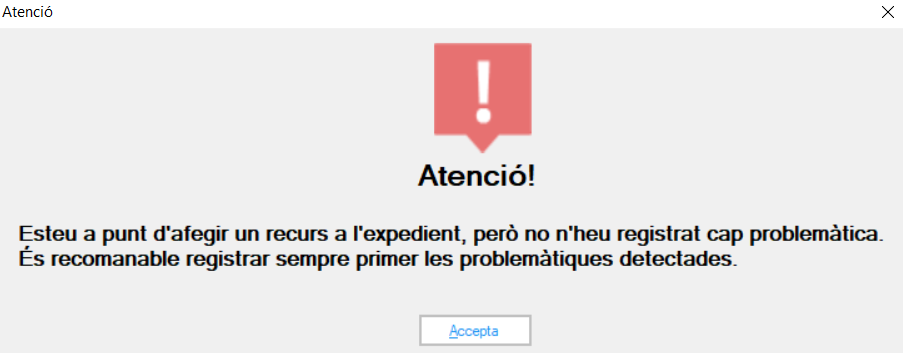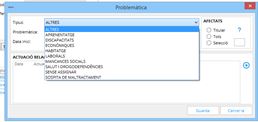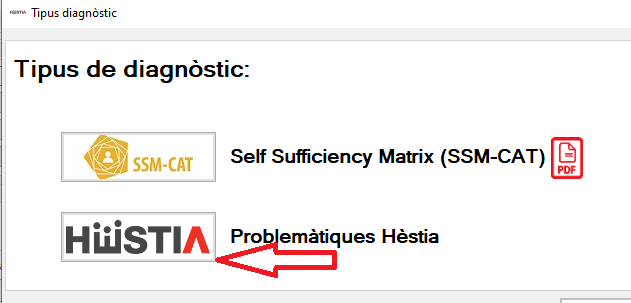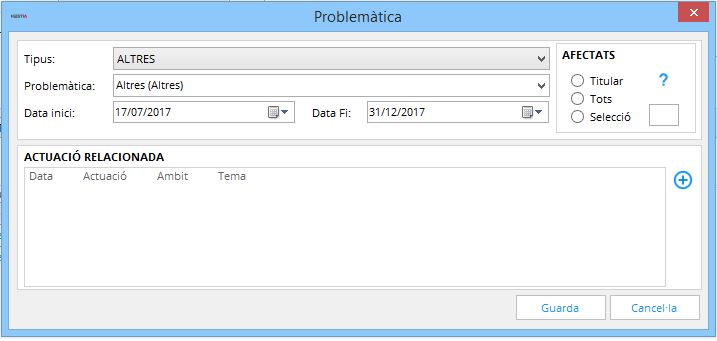From the moment the social services professional attends to the person, a process begins through which the situation is investigated and known and, at the same time, the data provided by the user is ordered and organized in the space of the 'interview, identifying in this way, among other aspects, the problems. These have been called "Hestia problems" in order to easily differentiate them from the diagnostic reports resulting from screening tools available to professionals, such as the SSM-CAT. These screening tools support and support the professional's decisions when it comes to alleviating the situation of the person they accompany.
Once the professional has recorded the action and the demand, he/she will record the problem/situation detected, which is clear from the interview space. It is very important to record the problems that the professional detects in his diagnosis, since these will allow us to evaluate the actions and decisions taken, cross-checking their data with action plans and resources applied for their solution or improvement. In order to remind professionals of the importance of registering problems, a reminder notice has been incorporated in case it is detected that the professional adds a resource to a person or family, without having registered any problems detected.

L'Hèstia allows you to register the problems collected in the "Unified register of data of local bodies" ( RUDEL ), classified by Type and Problem.

Once they are registered, the problems can be extended. Both the start date and the end date can be changed at any time by editing the issue. This aspect must be kept in mind in the face of long-term situations, such as problems related to disability situations, or many others. In these cases, the professional can extend the end date of the one provided by default.
The start and end dates are relevant for the realization of the RUDEL, given that in the event that this problem is not valid during the selected period, it will not count in the specific variable of problems.
Register a problem
To add a problem, click directly on the "Hestia" button of the "Hestia Problems", in the "Diagnostics" option in the menu of the person linked to the file

and fill out the form with the following information:
- Type of problem: to be chosen according to the glossary of types included in the form itself.
- Start date : date when the problem started. By default, the program sets the day on which the problem is introduced as the start date, and December 31 of the current year as the end date.
- End Date : end date of the issue.
- Linking with some previous performance: if deemed appropriate.

Both the start date and the end date can be changed at any time by editing the issue. This aspect must be kept in mind in the face of long-term situations, such as problems related to disability situations, or many others. In these cases, the professional can extend the end date that Hèstia has by default.
Another mandatory and at the same time important field to register is that of the affected people. It is important to select whether the problem affects only the selected person, or other people linked to the file. In the event that the problem that is recorded affects more people, you will need to select which ones through the "Selection" checkbox, to be able to select which ones, or "All". If it only affects the selected person, it will be necessary to mark it as such, choosing the "Owner" option in the "AFFECTED" section. This section is also important when accounting for RUDEL.
Once all the fields have been filled in, you must press the "Save" button so that the problem is registered.
In the event that you want to add the same problem to more than one person from those linked to the file, before adding it, you must select the people to whom you want to add this problem, through the selection box which is next to the name of the linked tab. The button will then be activated in order to be able to add any object (actions, demands, problems and resources).
Consult and modify problems
Through the "Diagnostics" tab of the SSB File, the technical professional will be able to view and/or access the problems registered to the persons linked to the file.
 The registered problems shown are ordered by date from the last "Hestia problem" and/or diagnosis of a screening tool registered in the file.
The registered problems shown are ordered by date from the last "Hestia problem" and/or diagnosis of a screening tool registered in the file.
To be able to access the problem, you must click on each of them. The order in which they are displayed can be changed by pressing the header of one of the columns.
To modify them, you must open the specific problem, modify the data and save the changes.
If it is necessary to delete a problem that has been created by mistake, we will use the "Delete" button in the corresponding row. This functionality is only enabled by the coordinators, and some technicians enabled by the latter.


